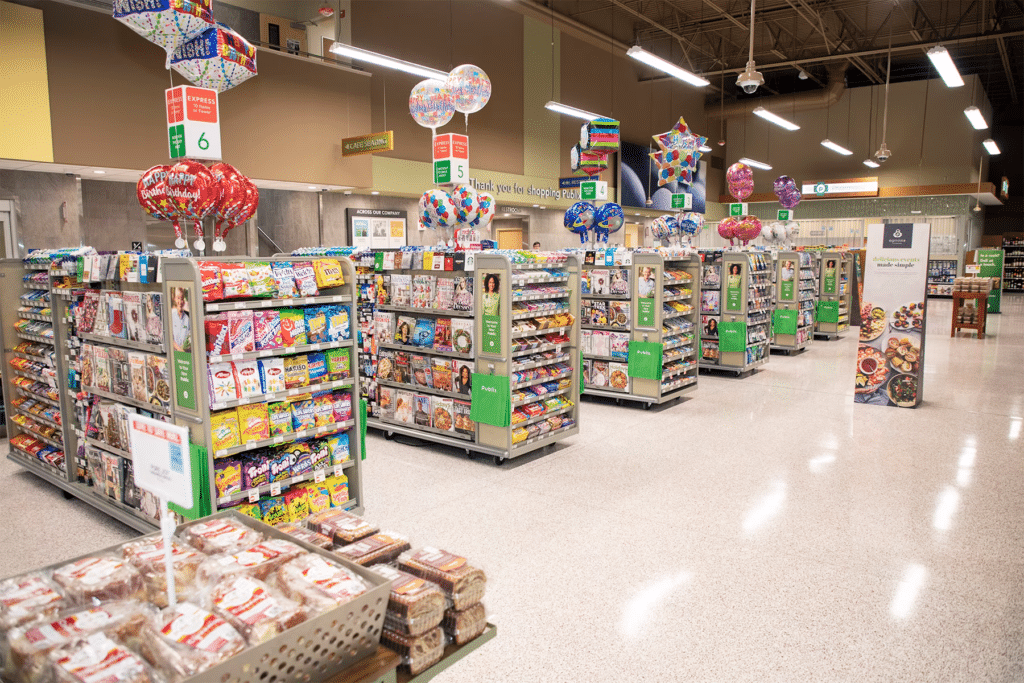
Apparently, we’re grocery shopping like it’s 2018 again. Having a pleasant shopping experience while saving money has been difficult to do in recent years. But a new annual survey finds our satisfaction with our local grocery stores is now at the highest it’s been in six years, thanks in part to “better sales and promotions.”
The American Customer Satisfaction Index is out with its latest annual ranking of American grocery chains, based on how satisfied survey respondents were with their recent shopping experiences. On a scale of 1-100, the grocery sector as a whole earned a score of 79, up three points from last year, matching the score it earned way back in pre-Covid, pre-inflation 2018. And every one of the stores on the list scored either the same as, or better than, last year. In a survey with constant annual fluctuations, it’s notable that none of the retailers declined in customer satisfaction levels.
The new rankings come “as food inflation slows and consumers perceive stronger value through better sales and promotions,” the ACSI notes. And the three-way tie for first place features a trio of stores that offer value in very different ways, as they all beat out another popular grocery chain’s long reign at the top of the list.
From best to worst, here are the ACSI’s latest ratings, as shoppers named their favorite stores – and their least favorite:
1. Costco/H-E-B/Publix (tie, 85)
Each year, many of the same names battle it out for positions near the top of the list. This year is no different, except that the top spot is shared by three retailers – pushing the longtime winner down to second place. Costco is one of the new favorites of many value-seeking customers, “as more shoppers gravitate toward their private-label offerings,” the ACSI notes. “Costco’s Kirkland Signature is considered ‘cool’ and has become one of the main reasons people go to the store these days.” H-E-B also won a recent dunnhumby grocery ranking, “due to their superior ability to deliver a combination of better savings and better experience/assortment.” And Publix is the epitome of the high-low grocery store, with high regular prices but low sale prices that bring plenty of satisfied customers through the doors week after week. Depending on the type of deals you like best, there’s something for everyone at the top of the list this year.
4. Trader Joe’s (84)
Trader Joe’s, with its popular store brands and low everyday prices, was number one for the past five years in a row. This year, consistency worked against it – while its score was steady at 84, that wasn’t good enough for first place this time, as the trio of winners jumped several ratings points to vault over TJ’s for the top spot. So the former number-one hasn’t done anything wrong, per se – it’s just that the others this year seem to have done more things right.
5. Sam’s Club (83)
As shoppers look to get more for less, Sam’s Club “also sees a gravitational pull toward its private label,” the ACSI found. The club store’s score rose several points, from last year’s middle of the pack to the top tier this year, as shoppers express satisfaction with Sam’s savings.
6. BJ’s Wholesale Club/Target/Wegmans/Whole Foods (tie, 82)
BJ’s rounds out the club store sector, sharing the crowded number-six position with several very different types of grocery retailers. Target has always been known as a general merchandise retailer that also sells groceries, instead of the other way around. Whole Foods has never been known as a low-price leader, though its pricey reputation is moderating somewhat under Amazon’s ownership. And Wegmans has improved a couple of points from last year, but it’s never been able to recapture the magic that it had back in 2016, the one and only year it was number one.
10. ALDI (81)
ALDI isn’t really known for its sales and promotions, as shoppers instead seek out its low prices. But the small-format retailer is about to get a crash course in sales and promotions, as it’s expected to close soon on the purchase of the much more promotional Winn-Dixie grocery chain. Will Winn-Dixie start to look like ALDI, or vice versa? Next year’s survey should give us an idea of how shoppers think it all turned out.
11. Meijer/ShopRite (80)
A middle-of-the-pack finish may not seem impressive, but both Meijer and ShopRite experienced the biggest year-over-year jumps, each of them improving five points to earn a score of 80. They may not be at the top of the list, but at one point above the grocery sector’s overall rating, that still counts as above average.
13. “All others” (79)
What if you shop at, say, Winn-Dixie, or Schnucks, or any other regional grocery chain that’s not on this list? Well, that’s what “all others” is for. This listing combines every grocer named in the survey, but not often enough to be ranked separately. And this year, there’s a bit of equilibrium to the rankings – “all others” is all by itself, with the very same score as the grocery category as a whole. So if your local store isn’t on the list – you can officially consider it perfectly average.
14. Albertsons/Hy-Vee (78)
And now we get to the below-average portion of the survey. Albertsons rose four points and Hy-Vee rose two, so they’re improving – just not enough to break into the top half of the rankings. For Hy-Vee, that’s about par for the course, as it’s always landed around the middle of the pack. But for Albertsons, a single point below the average score is a huge improvement from where it’s been recently – third from last in last year’s survey, second to last the year before, and dead last the year before that. If its planned merger with Kroger is approved this year, Albertsons will no longer be ranked separately – so considering the alternative, almost average isn’t a bad way to go out.
16. Ahold Delhaize/Kroger (77)
Speaking of Kroger, it landed on the list one point below its planned new partner, tied with Food Lion and Shop & Shop owner Ahold Delhaize. It’s a relatively familiar position for both, except that Kroger usually finishes ahead – sometimes far ahead – of Albertsons. Could it have something to do with Kroger no longer distributing printed sales circulars? It’s hard to appeal to deal-seeking shoppers, after all, when many of them no longer know what the deals are. Regardless of the reason, Kroger seems to be falling behind just as Albertsons is making a steady climb out of last place – so shoppers can only hope the two are better together.
18. Giant Eagle (76)
Giant Eagle still has printed weekly circulars – it tried getting rid of them last year, but soon reversed course. That may or may not have helped it rise in the rankings by three points from last year. But in the history of the ACSI survey, Giant Eagle has always been at or near the bottom. And it seems this year is no exception.
19. Save A Lot (75)
Save A Lot is another example of a store that fell behind by standing still. Last year, Save A Lot’s score of 75 was enough for an appearance in the middle of the rankings. This year, its score held steady but its ranking didn’t – with most other stores improving, a lack of improvement is as good as a loss, as Save A Lot now finds itself ranked second to last.
20. Walmart (74)
How’s this for consistent – Walmart finds itself at the bottom of the ACSI list, for an astonishing nineteenth year in a row. But it’s not all bad news – Walmart has shown some improvement, as its rating is up four points from last year, for its strongest showing since 2020. But Walmart was dead last back then, too. With every other retailer rising in the rankings, even an improved Walmart apparently isn’t good enough.
So what accounts for the same-or-better ratings across the board this year? “Issues stemming from the pandemic, including supply disruptions and uneven service quality, are dissipating,” ACSI Director of Research Emeritus Forrest Morgeson said in a statement. “Moderating inflation is helping to improve the value proposition,” and the higher ratings show that “consumers looking to stretch their dollars responded positively to discounters and retailers that excelled in sales and promotions or pumped more value into the experience through private label offerings.”
After a tumultuous few years, we’d all like nothing more than a return to normal. Grocery sales and promotions may not be as good as they once were. But this year’s findings show that shoppers are more than ready to reward stores that offer them.
Image source: Publix















